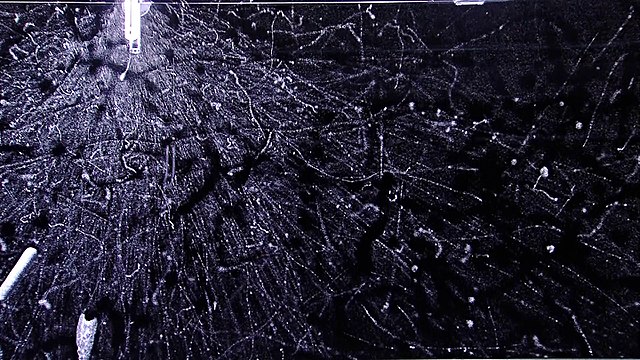A beta particle, also called beta ray or beta radiation, is a high-energy, high-speed electron or positron emitted by the radioactive decay of an atomic nucleus during the process of beta decay. There are two forms of beta decay, β− decay and β+ decay, which produce electrons and positrons respectively.
Blue Cherenkov radiation light being emitted from a TRIGA reactor pool is due to high-speed beta particles traveling faster than the speed of light (phase velocity) in water (which is 75% of the speed of light in vacuum).
Beta radiation detected in an isopropanol cloud chamber (after insertion of an artificial source strontium-90)
The electron is a subatomic particle with a negative one elementary electric charge. Electrons belong to the first generation of the lepton particle family, and are generally thought to be elementary particles because they have no known components or substructure. The electron's mass is approximately 1/1836 that of the proton. Quantum mechanical properties of the electron include an intrinsic angular momentum (spin) of a half-integer value, expressed in units of the reduced Planck constant, ħ. Being fermions, no two electrons can occupy the same quantum state, per the Pauli exclusion principle. Like all elementary particles, electrons exhibit properties of both particles and waves: They can collide with other particles and can be diffracted like light. The wave properties of electrons are easier to observe with experiments than those of other particles like neutrons and protons because electrons have a lower mass and hence a longer de Broglie wavelength for a given energy.

A beam of electrons deflected by a magnetic field into a circle
J. J. Thomson
Robert Millikan
A lightning discharge consists primarily of a flow of electrons. The electric potential needed for lightning can be generated by a triboelectric effect.






